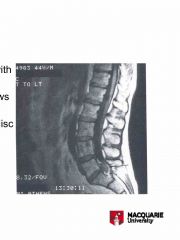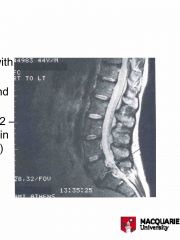![]()
![]()
![]()
Use LEFT and RIGHT arrow keys to navigate between flashcards;
Use UP and DOWN arrow keys to flip the card;
H to show hint;
A reads text to speech;
49 Cards in this Set
- Front
- Back
|
who was CT developed by what year |
1970 Godfrey Hounsfield |
|
|
what kind of beam is direted onto patient |
well collimated xray beam |
|
|
what is attenuated radiation measured by |
solid state image receptor |
|
|
where does this info go to? |
a computer to reconstruct the cross sectional image on the monitor |
|
|
how does the xray source and source detetor move synchronously? |
they are connected |
|
|
what how is CT operated |
1. xray moved across patient to obtain a single projection 2. assembly rotates then moves across the patient again obtaining a second projection 3. repition 4. images superimposed to reconstruct the volume of the area imaged |
|
|
how can CT be formatted |
by computer to show 1. axial 2. coronal 3. sagittal slices of the area imaged |
|
|
early design has improved (2) |
1. imaging times (decreased it) 2. imaging detail |
|
|
CT has not decreased what? |
patient dose |
|
|
The Hounsfield scale (grey scale) air = fat = water = blood = soft tissue = clotted blood = bone calcification = dense bone = metal = |
air = -1000 fat = -50 water = 0 blood = 12 soft tissue = 35 clotted blood = 40 -60 bone calcification = 800 dense bone = 1000 metal = 3000 |
|
|
contrast and brightness brightness is known as contrast is known as |
window level window width |
|
|
brightness/window level will: contrast/window width will: |
picks midrange HU picks the range of HU btw white and black |
|
|
the lowest cut off will visualise anything below it as: |
black |
|
|
the highest gut off will visualise anything above it as |
white |
|
|
calculate the lowest cutoff calculate the highest cutoff |
WL - (WW/2) WL + (WW/2) |
|
|
a soft tissue window is around a bone window is around |
WW: 350 HU WL: 40HU WW: 1900 HU WL: 300HU |
|
|
what are CT advantages (4) |
soft tissue attenuation increased by 10x - can visualise brain liver, disc able to view axial images of spine reformatting to view coronal and sagittal slices and 3D representations Improved bone diagnosis |
|
|
what are the disadvantages of CT (60 |
1. radiation dose! 2. high cost 3. artifact from metal 4. long exposure time 5. small seze of gantry 6. claustrophobia |
|
|
Effective doses in CT vs radiographic exam Head Chest Ab Pelvis |
2 vs 0.07 8 vs 0.02 10-20 vs 1 10-20 vs 0.7 |
|
|
do other organs receive uneccessary dose in CT even though they arent the target of imaging? |
yes breast = 20-50mGy Eye and thyroid in brain or throax imaging gonads in pelvic imaging |
|
|
CT is the large dose despite being on of the --- frequencies |
smallest |
|
|
Ct is one of the most important examinations CT frequency is increasing rapidly in Aus GPs have a hard time referring MRI but not Ct |
true true true |
|
|
when and who developed MRI |
fleix bloch and Ed Purcell 1946 |
|
|
does MRI use ionising radiation |
no |
|
|
what is the basic method of obtaining an image |
magnetic field + RF --> mathematically reconstructed image |
|
|
what is the function of the magnetic field |
align magnetic moments of atoms |
|
|
what us the function of the Radiofrequency field |
alter alignment of the magnetisation which causes nuclei to produce rotating magnetic field specific to each tissue type |
|
|
what does an MRI image represent |
differences among tissues in the number of nuceli and the rate at which nuclei recover from stimulation by radiowaves in presence of magnetic field |
|
|
radiography involves interaction of ---- with ---- MRI involves interation of ---- (and static magnetic fields) with ---- |
xrays with electrons radiwaves with nuclei alone |
|
|
not all nuclei respond to magnetic fields. what is required of the nuclei to respond? |
must have odd number of protons |
|
|
what are nuclei suitable for MRI |
K H Fl Na P |
|
|
what is atom used for MRI |
H |
|
|
what is precession |
spinning of protons around the magnetic field direction when they are aligned to magnetic field the wobble is due to gravity and occurs whenever a spinning object is acted apon by outside force |
|
|
when will rate of precession increase |
with increasing magnetic field strenght |
|
|
how else will precession increase |
after static magnetic field is applied radiowaves cause precession of nucleus at greater angle |
|
|
the longer the radiowave is applied, the ---- the angle of precession |
greater |
|
|
what is resonance what is H resonance frequency |
the aborption or emission of energy only at certain frequencies Larmor frequency (42.3 megahertz per tesla 42.3MHz/T) |
|
|
H proton in 1-T field will strongly absorb energy only from ---- RF |
42.3MHz |
|
|
what is the result of a lamor frequency on H (2) |
1. rotates protons out of longitudinal alignment and into tranverse alignment 2. cause nuclei to move in phase with each other (phase coherence) |
|
|
why can an antenna/receiver coild pick up MRI signal |
nuclei are tiny magents and emit EM waves as it rotates. these are picked up when they are in transverse alignment and sent to computer |
|
|
relaxation occurs when the ---- pulse is over and the protons --- again. At this point the signal --- what gives information about normal tissue and pathological process in tissue |
RF precess diminishes the rate of relaxation |
|
|
relaxation is divided into 2 categories |
T1 relaxation T2 reaxation |
|
|
what is T1 relaxation |
time it takes from a proton to precess back into alignment with external magneitc field (back into longitudinal alignment) |
|
|
T1 relaxation shows high intesity with ----
epidural fat will show ---
you can visualise |

fat
white
large extruded disc herniation |
|
|
T2 relaxation of tissue |
is time for protons to lose their phase. when spin begin to precess out of phase with each other when RF stops: loss of phase coherence (result is referred to as transverse or spin-spin type relacation |
|
|
T2 time is always --- than its T1 relaxation time |
shorter |
|
|
T2 has high intesity with hydrated dic and CSF show
a herniated disc will show low signal because |

water white there isnt much water in it |
|
|
what are the advantages of MRI (3) |
1. 100x better soft tissue attenuation than Ct 2. best for disc disease 3. no known harmful effects |
|
|
what are the disadvantages of MRI (4) |
1. high cost 2. unsuitable if ferrous metals present in patient 3. poor for bony pathology 4. small gantry |

